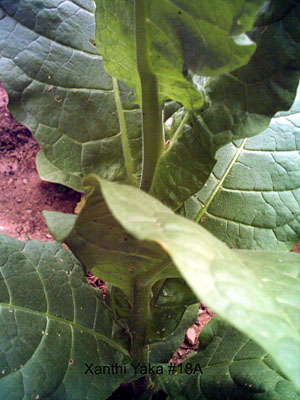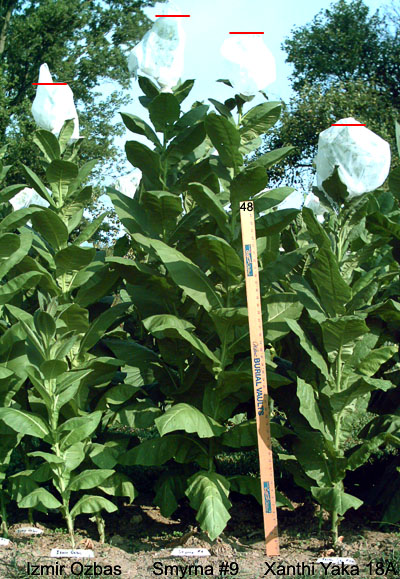Here, I discuss the physical attributes of Izmir Ozbas, Smyrna #9 and Xanthi Yaka #18A, since I am currently growing these. All three were sourced from the National Plant Germplasm System - GRIN Nicotiana Collection.
İzmir is the Turkish name for the ancient city of Smyrna. So Izmir and Smyrna are two names for the same place, located on the eastern coast of the Aegean Sea. About 230 miles away to the northwest (as the Turkish crow flies), across the Aegean, and up into the Rhodope mountain range, lies the Greek (formerly Ottoman) town of Xanthi.

I had some trouble figuring out what the "Ozbas" portion of Izmir Ozbas signified. There is no town or region in western Turkey called Ozbas, though there is a tiny village in the non-tobacco district of south-central Turkey called Ozbas. The word, "ozbas," or more correctly in Turkish orthography, "özbaş," does not appear in any Turkish dictionary that I can locate, though there are Turkish individuals with the surname of Ozbas. However, I did come up with the following:
özbaş
öz = original or true
baş = basis or head
So, İzmir özbaş (Izmir Ozbas) likely indicates an early or "original" Izmir (Smyrna) cultivar.
Solely on the basis of the plant's morphology, Izmir Ozbas is clearly related to Smyrna #9, though a distinctly separate variety. [The ruler shown in the image is 48", rather than a 3' yard stick.]

A quick glance at the two varieties contrasts the larger, smoother, shinier leaf of Smyrna #9 with the smaller, duller, rougher leaf of Izmir Ozbas. Izmir Ozbas is noticeably more pubescent (fuzzy) than Smyrna #9. The Izmir Ozbas leaves are smaller and more rugose (bumpy). Another interesting attribute of Izmir Ozbas is that the normal lateral curvature of the leaf laminae away from the central vein reverses at the leaf margin, with a slight upcurve, creating a small lip. This "lip" is not present on Smyrna #9.

Despite Izmir Ozbas' greater pubescence, the leaf surface is less sticky to touch than is that of Smyrna #9. This is surprising, since the glands that secrete the sticky compounds are located in the hairs.
If we look at the leaf attachment to the stalk, and the "ruffle" that extends from the leaf laminae onto the sides of the stalk, further differences are evident. The ruffle of the Izmir Ozbas is relatively flat and smoothly tapered, and extends straight down the stalk on either side of the leaf base. It appears to form a 90º angle from one side of the ruffle to the other. In contrast, the ruffle of Smyrna #9 tends to be rippled, uneven, and somewhat less defined in its angle.

If we add a comparison of Izmir Ozbas (from western Turkey) with Xanthi Yaka #18A , also known as Yenidje leaf, (from what is now Greece) the two are far more similar in morphology than Izmir Ozbas is to Smyrna #9. Xanthi Yaka (distinguished from Xanthi Djebel, which is grown at higher elevations in the Rhodope mountain range above the town of Xanthi) lacks the upturned rim on the leaves, and is less pubescent than Izmir Ozbas, but it is of similar size and equally rugose. Xanthi Yaka #18A's ruffle is less well defined than that of Izmir Ozbas.

I would venture to suggest that the two were originally from the same seed, and that their distinctive differences in the cured and fermented leaf a hundred years ago were originally determined by differences in soil, climate and fertilization practices. As a larger tobacco industry developed about the region of Izmir, cultivars such as Smyrna #9 were developed in the twentieth century to enhance various preferred production attributes.
Of the three varieties discussed, the Xanthi Yaka 18A seems to be the most primitive, or least "enhanced."
Samsun, Bafra, Trebizon, and a few other Orientals comprise a separate class, as does Shirazi, and will be discussed in a separate thread.
Bob
- Izmir-Ozbas: Turkey 1984 GRIN_Pi494157
- Smyrna No.9: Turkey 1962 GRIN_Pi552414
- Xanthi Yaka No.18A: Greece 1962 GRIN_Pi552418
İzmir is the Turkish name for the ancient city of Smyrna. So Izmir and Smyrna are two names for the same place, located on the eastern coast of the Aegean Sea. About 230 miles away to the northwest (as the Turkish crow flies), across the Aegean, and up into the Rhodope mountain range, lies the Greek (formerly Ottoman) town of Xanthi.

I had some trouble figuring out what the "Ozbas" portion of Izmir Ozbas signified. There is no town or region in western Turkey called Ozbas, though there is a tiny village in the non-tobacco district of south-central Turkey called Ozbas. The word, "ozbas," or more correctly in Turkish orthography, "özbaş," does not appear in any Turkish dictionary that I can locate, though there are Turkish individuals with the surname of Ozbas. However, I did come up with the following:
özbaş
öz = original or true
baş = basis or head
So, İzmir özbaş (Izmir Ozbas) likely indicates an early or "original" Izmir (Smyrna) cultivar.
Solely on the basis of the plant's morphology, Izmir Ozbas is clearly related to Smyrna #9, though a distinctly separate variety. [The ruler shown in the image is 48", rather than a 3' yard stick.]

A quick glance at the two varieties contrasts the larger, smoother, shinier leaf of Smyrna #9 with the smaller, duller, rougher leaf of Izmir Ozbas. Izmir Ozbas is noticeably more pubescent (fuzzy) than Smyrna #9. The Izmir Ozbas leaves are smaller and more rugose (bumpy). Another interesting attribute of Izmir Ozbas is that the normal lateral curvature of the leaf laminae away from the central vein reverses at the leaf margin, with a slight upcurve, creating a small lip. This "lip" is not present on Smyrna #9.

Despite Izmir Ozbas' greater pubescence, the leaf surface is less sticky to touch than is that of Smyrna #9. This is surprising, since the glands that secrete the sticky compounds are located in the hairs.
If we look at the leaf attachment to the stalk, and the "ruffle" that extends from the leaf laminae onto the sides of the stalk, further differences are evident. The ruffle of the Izmir Ozbas is relatively flat and smoothly tapered, and extends straight down the stalk on either side of the leaf base. It appears to form a 90º angle from one side of the ruffle to the other. In contrast, the ruffle of Smyrna #9 tends to be rippled, uneven, and somewhat less defined in its angle.

If we add a comparison of Izmir Ozbas (from western Turkey) with Xanthi Yaka #18A , also known as Yenidje leaf, (from what is now Greece) the two are far more similar in morphology than Izmir Ozbas is to Smyrna #9. Xanthi Yaka (distinguished from Xanthi Djebel, which is grown at higher elevations in the Rhodope mountain range above the town of Xanthi) lacks the upturned rim on the leaves, and is less pubescent than Izmir Ozbas, but it is of similar size and equally rugose. Xanthi Yaka #18A's ruffle is less well defined than that of Izmir Ozbas.

I would venture to suggest that the two were originally from the same seed, and that their distinctive differences in the cured and fermented leaf a hundred years ago were originally determined by differences in soil, climate and fertilization practices. As a larger tobacco industry developed about the region of Izmir, cultivars such as Smyrna #9 were developed in the twentieth century to enhance various preferred production attributes.
Of the three varieties discussed, the Xanthi Yaka 18A seems to be the most primitive, or least "enhanced."
Samsun, Bafra, Trebizon, and a few other Orientals comprise a separate class, as does Shirazi, and will be discussed in a separate thread.
Bob



